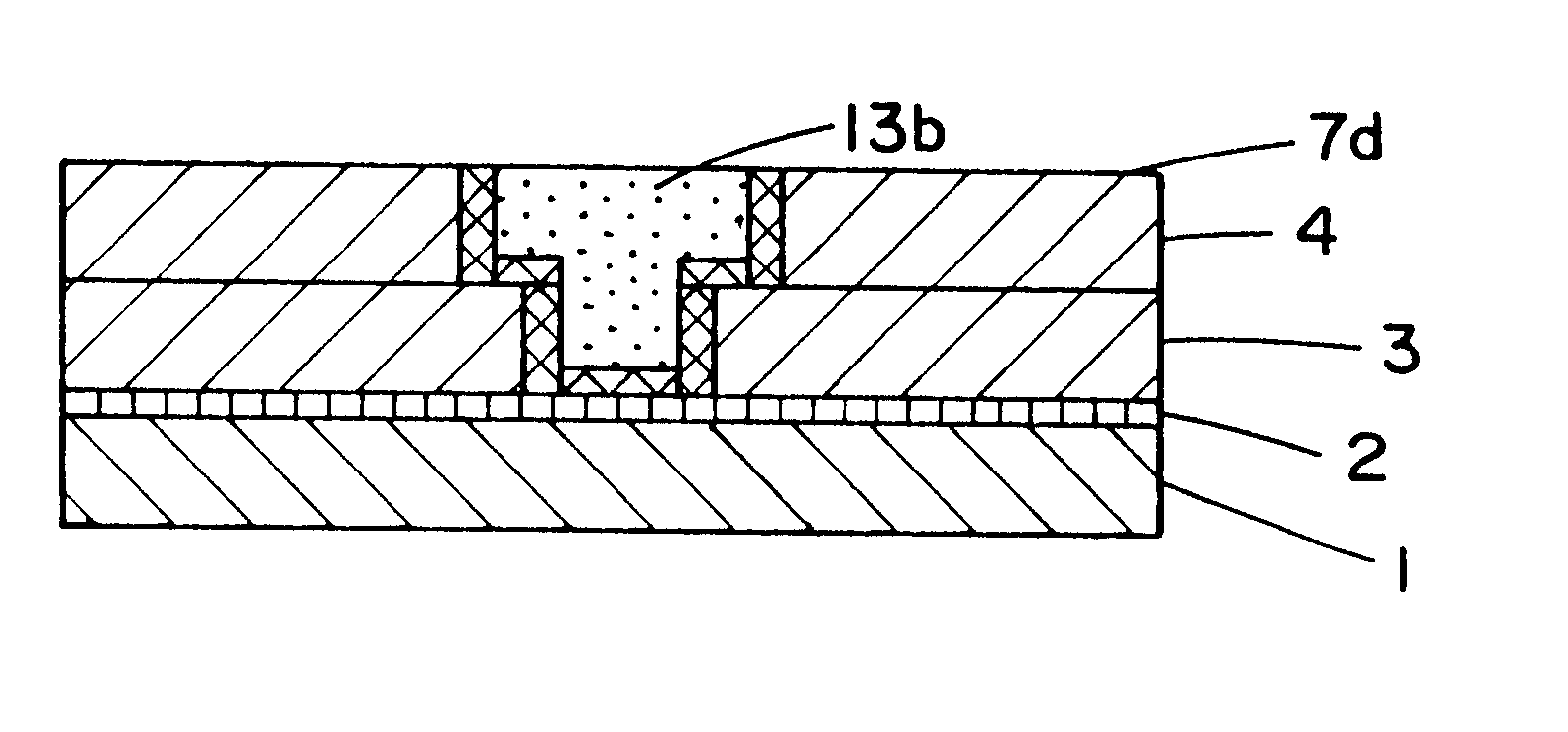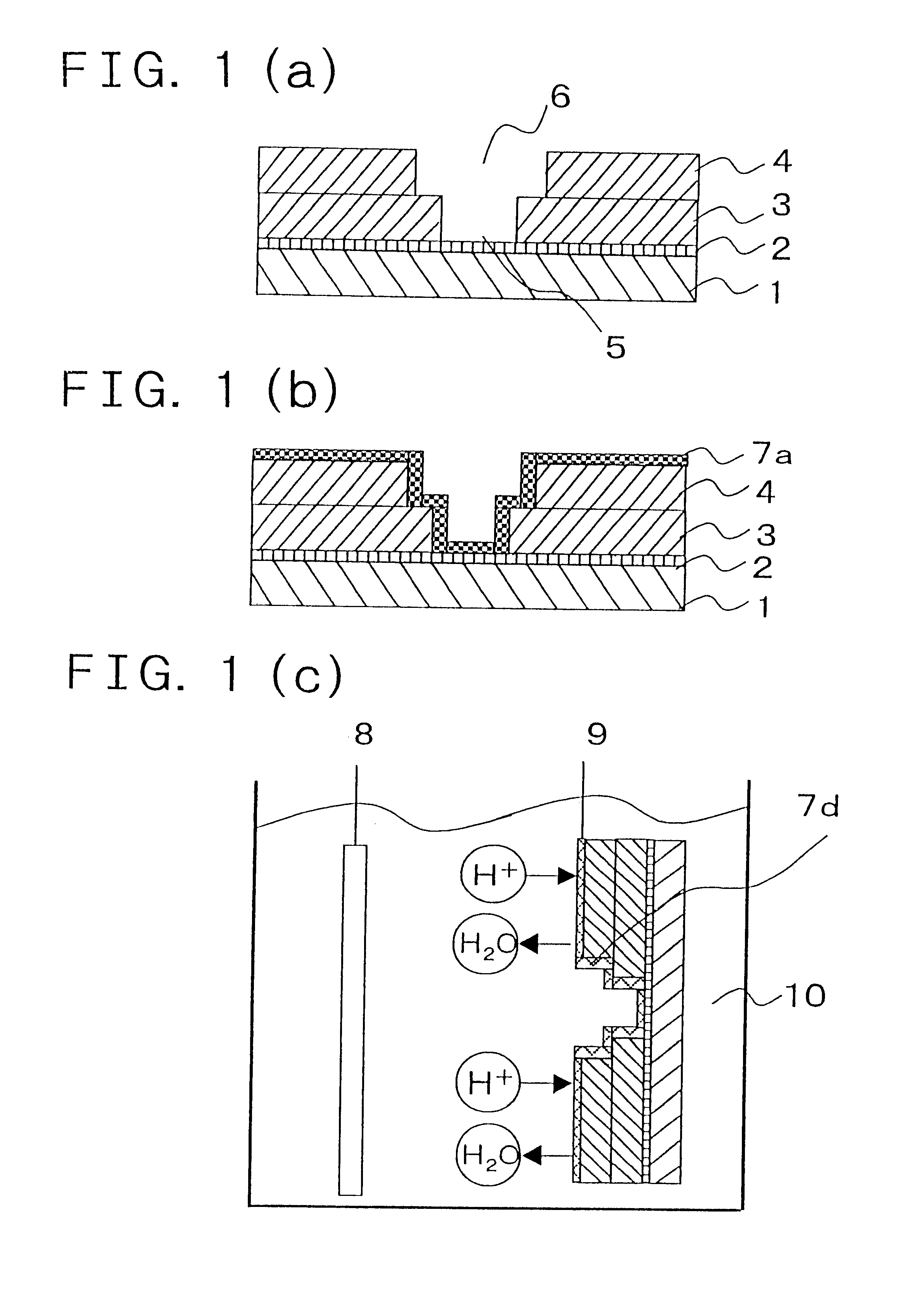Process for forming fine wiring
a technology of fine wires and wires, applied in the direction of liquid/solution decomposition chemical coating, metallic material coating process, coating, etc., can solve the problems of metal embossed, resultant device malfunction, etc., and achieve the effect of low resistance and good quality
- Summary
- Abstract
- Description
- Claims
- Application Information
AI Technical Summary
Benefits of technology
Problems solved by technology
Method used
Image
Examples
example 1
A first example of the present invention will now be explained. FIGS. 1 and 2 are schematic sectional views explaining the first example of the process for forming a fine wiring in accordance with the present invention. They are sectional views showing a sequence of steps of the process of forming the fine wiring. FIGS. 1 and 2 are divided for convenience of formulating of the drawing.
Referring now to FIG. 1, a lower layer wiring 2 is formed on a silicon substrate 1 in which elements such as transistors are formed. A first interlayer insulating film 3 having a thickness of 10 nm to 1000 nm is formed on the lower layer wiring 2 and a second interlayer insulating film 4 having a thickness of 10 nm to 1500 nm is formed on the film 3. At this time, these interlayer insulating films are formed by a CVD or coating process. Material to be used may include inorganic materials such as silicon oxide, fluorine-containing silicon oxide, polysilazane, hydrogensilsesquioxane, organic materials su...
example 2
A second example 2 of a process for forming fine wiring in accordance with the present invention will be described.
FIG. 3 is a schematic sectional view explaining the second example of the present invention. The second example 2 is identical with the first example 1 except that the plating step as shown in FIG. 2(d) in the latter example is replaced by an electroless plating step shown in FIG. 3 in the former example 1. The second example of the present invention will be described with reference to FIGS. 1 through 3.
Referring now to FIG. 1, a pattern in which wiring material will be buried or embedded is formed as similarly to the first example. For example, a metal film 7a, e.g., tantalum oxide film is formed (FIG. 1(b)) and is then electrochemically reduced to a metal film e.g., tantalum 7d (FIG. 1(c)).
Referring now to FIG. 3, a substrate 1 having the metal film 7d, e.g., of tantalum film, thereon is dipped into an electroless plating bath 14 in which ions of copper such as copper...
first embodiment
A major difference between the first and second examples resides in that copper which will be a wiring material is formed by the electroless plating process after the film of a metal oxide which is excellent in coverage is reduced to the metal. An apparatus using the electroless plating process in the second example is lower in cost and enables more mass production in comparison with the A film having less pinholes can be formed over the entire of the substrate.
A third example of the present invention will be described. FIG. 4 is a schematic sectional view explaining the third example of the present invention. FIG. 4 shows, a step in the third example which is added between the reducing step as shown in FIG. 1(c) explaining the first example and the plating step of FIG. 2(d). The third example of the present invention will be described with reference to FIGS. 1, 2 and 4.
Referring now to FIG. 1, in the third Example of the present invention a pattern in which the wiring material is ...
PUM
| Property | Measurement | Unit |
|---|---|---|
| thickness | aaaaa | aaaaa |
| thickness | aaaaa | aaaaa |
| size | aaaaa | aaaaa |
Abstract
Description
Claims
Application Information
 Login to View More
Login to View More - R&D
- Intellectual Property
- Life Sciences
- Materials
- Tech Scout
- Unparalleled Data Quality
- Higher Quality Content
- 60% Fewer Hallucinations
Browse by: Latest US Patents, China's latest patents, Technical Efficacy Thesaurus, Application Domain, Technology Topic, Popular Technical Reports.
© 2025 PatSnap. All rights reserved.Legal|Privacy policy|Modern Slavery Act Transparency Statement|Sitemap|About US| Contact US: help@patsnap.com



